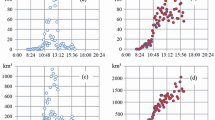Abstract
The three-dimensional nonstationary model of a convective cloud is used for investigating a thunderstorm with hail which developed over Pyatigorsk on May 29, 2012 and produced a severe hailstorm. The values of cloud characteristics (liquid water content, ice content, vertical velocity, etc.) are obtained. The importance ofconsidering wind shear is noted. The simulation results are used to analyze the transformation of precipitation field and the electric charge structure of the analyzed cloud during its development.
Similar content being viewed by others
References
B. A. Ashabokov, L. M. Fedchenko, V. O. Tapaskhanov, et al., Physics of Hail Clouds and Their Modification: Current State and Development Trends (Pechatnyi Dvor, Nalchik, 2013) [in Russian].
N. E. Veremei, Yu. A. Dovgalyuk, and V. N. Morozov, “Parameterization of Microphysical Processes in Numerical Models of Thunderstorm Clouds,” Meteorol. Gidrol., No. 11 (2006) [Russ. Meteorol. Hydrol., No. 11, 31 (2006)]
V. V. Voevodin, S. A. Zhumatii, S. I. Sobolev, et al., The Practice of the “Lomonosov” Supercomputer. Open Systems (Izdatel’skii Dom “Otkrytye Sistemy”, Moscow, 2012) [in Russian].
Yu. A. Dovgalyuk, N. E. Veremei, S. A. Vladimirov, et al., “Conception of the Development of the Three-Dimensional Model of a Precipitating Convective Cloud. Part I: Model Structure and Basic Equations of the Hydrothermodynamic Block,” Trudy GGO, No. 558 (2008) [in Russian].
Yu. A. Dovgalyuk, N. E. Veremei, S. A. Vladimirov, et al., “Conception of the Development of the Three-Dimensional Model of a Precipitating Convective Cloud. Part II: The Microphysical Block of the Model,” Trudy GGO, No. 562 (2010) [in Russian].
Yu. A. Dovgalyuk, N. E. Veremei, and A. A. Sin’kevich, The Use of One-and-Half-Dimensional Model for Solving Fundamental and Applied Problems of the Cloud Physics, 2nd ed. (Mobi Dik, St. Petersburg, 2013) [in Russian].
I. P. Mazin and S. M. Shmeter, Clouds: Structure and Formation Physics (Gidrometeoizdat, Leningrad, 1983) [in Rus sian].
Yu. P. Mikhailovskii, A. A. Sin’kevich, S. D. Pawar, et al., “Investigations of the Development of Thunderstorm with Hail. Part 2. Analysis of Methods for the Forecast and Diagnosis of the Electrical Properties of Clouds,” Meteorol. Gidrol., No. 6 (2017) [Russ. Meteorol. Hydrol., No. 6, 42 (2017)]
R. S. Pastushkov, “The Effect of Vertical Wind Shear on the Convective Cloud Development,” Izv. Akad. Nauk, Fiz. Atmos. Okeana, No. 1, 9 (1973) [in Russian].
R. S. Pastushkov, “Development of Cumulus Clouds in the Atmosphere with Vertical Wind Shear,” Meteorol. Gidrol., No. 4 (1969) [in Russian].
R. S. Pastushkov, “Numerical Simulation of the Convective Cloud Interaction with the Ambient Atmosphere,” Trudy TsAO, No. 108 (1972) [in Russian].
R. S. Pastushkov and S. M. Shmeter, “The Effects of Vertical Wind Profile on the Development of High-depth Cumulonimbus Clouds,” in Proceedings of VAll-Union Meteorological Congress (Gidrometeoizdat, Leningrad, 1971) [in Russian].
A. A. Sin’kevich, Yu. P. Mikhailovskii, Yu. A. Dovgalyuk, et al., “Investigations of the Development of Thunderstorm with Hail. Part 1. Cloud Development and Formation of Electric Discharges,” Meteorol. Gidrol., No. 9 (2016) [Russ. Meteorol. Hydrol., No. 9, 41 (2016)]
S. M. Shmeter, Physics of Convective Clouds (Gidrometeoizdat, Leningrad, 1972) [in Russian].
T. Asai, “Cumulus Convection in the Atmosphere with Vertical Wind Shear,” J. Meteorol. Soc. Japan, No. 4, 42 (1964).
R. S. Pastushkov, “The Effect of Vertical Wind Shear on the Evolution of Convective Clouds,” Quart. J. Roy. Meteorol. Soc., 101 (1975).
T. Takeda, “Effect of the Prevailing Wind with Vertical Shear on the Convective Flow Accompanied with Heavy Rainfall,” J. Meteorol. Soc. Japan, No. 2, 44 (1966).
Author information
Authors and Affiliations
Corresponding author
Additional information
Original Russian Text © A.A. Sin’kevich, Yu.A. Dovgalyuk, N.E. Veremei, A.B. Kurov, Yu.P. Mikhailovskii, E.V. Bogdanov, M.L. Toropova, A.A. Ignat’ev, A.Kh. Adzhiev, A.M. Malkarova, A.M. Abshaev, V. Gopalakrishnan, P. Murugavel, S.D. Pawar, 2017, published in Meteorologiya i Gidrologiya, 2017, No. 8, pp. 18–28.
About this article
Cite this article
Sin’kevich, A.A., Dovgalyuk, Y.A., Veremei, N.E. et al. Investigations of the development of thunderstorm with hail. Part 3. Numerical simulation of cloud evolution. Russ. Meteorol. Hydrol. 42, 494–502 (2017). https://doi.org/10.3103/S1068373917080027
Received:
Accepted:
Published:
Issue Date:
DOI: https://doi.org/10.3103/S1068373917080027




